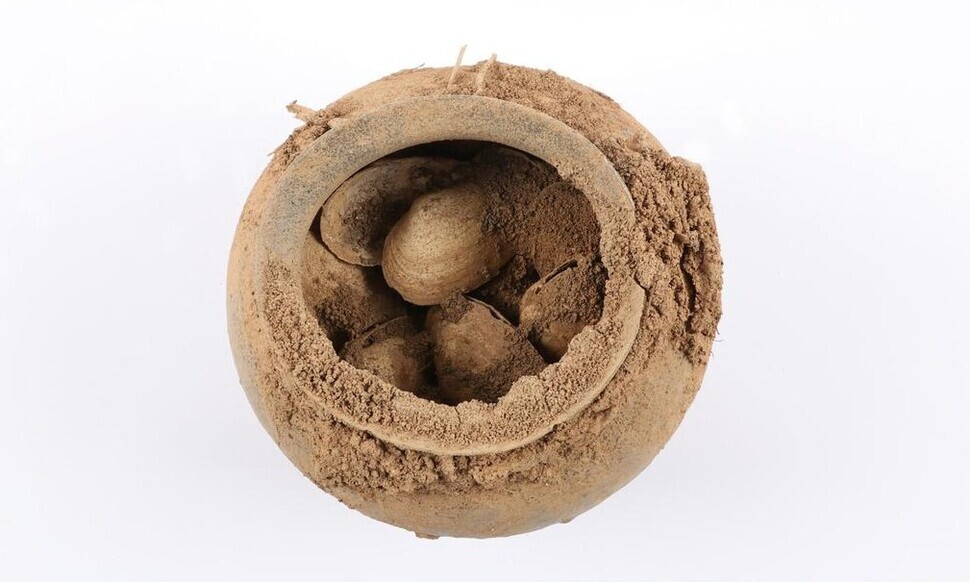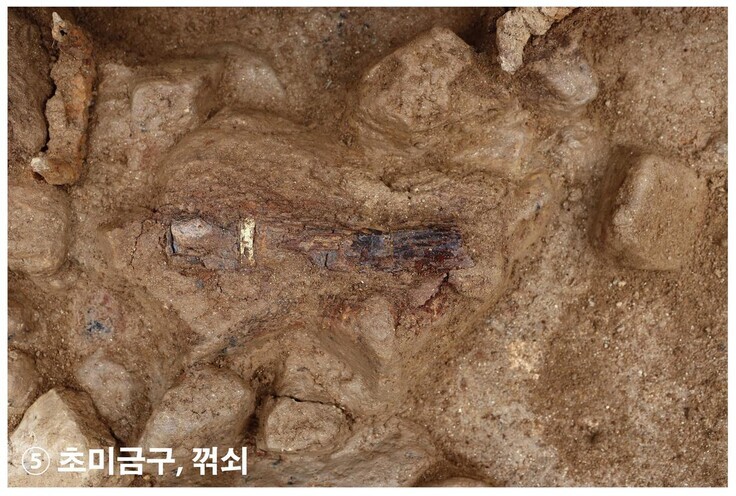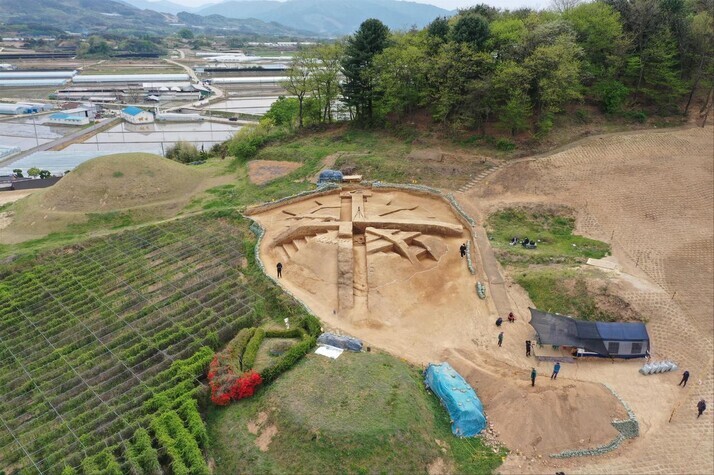hankyoreh
Links to other country sites 다른 나라 사이트 링크
1,500-year-old arrowheads, urns containing shells found in tomb in Namwon

An excavation in the inland mountains of Jeolla Province has turned up weapons such as arrowheads that were used by the warriors of Gaya 1,500 to 1,600 years ago.
Also discovered were various ornaments and shells from the shellfish that were consumed at the time.
The Wanju National Research Institute of Cultural Heritage announced discoveries Wednesday from its recent excavation of the No. 30 large tomb among the ancient Gaya-era tombs in the Durak village of Ayeong, a township in Namwon, North Jeolla Province.
They included metal arrowheads, flag holders attached to the horses residents rode at the time, scabbard decorations, and earthenware urns containing various shells.

The No. 30 tomb is believed to have been dug for a Gaya warrior in the late 5th or early 6th century. Most of the burial items have been lost to robbers, but the excavation has drawn attention for the discovery of a curving metal flag holder and scabbard-tip ornament — typically found in Silla and Gaya tombs from the 5th and 6th centuries — on the tomb floor where the body was placed.
A bundle of arrowheads was found along with earthenware shards in the clay used to seal a hole used by thieves in the wall of the grave’s chamber.

A separate chamber dug for burial items turned up a bowl rest in the Daegaya style and around 20 urns. Notably, some of the urns contained shells from soft clams and purple whelks native to the West and South Sea regions.
In the past, shells from clams, whelks, and other shellfish have been excavated in Gyeongju from the ancient Silla royal tombs of Geumnyeongchong and Seobongchong, and in the Yeongnam region from some Gaya-era tombs. But this is said to be the first time they have been found in a Gaya tomb in the Namwon region, located far inland.
The Cultural Heritage Administration has paired the ancient tombs located in Durak on the foothills of Mt. Yeonbi in Namwon with the neighboring tombs in the village of Yugok, referring to them collectively under the official title “Yugok/Durak Village Ancient Tombs.”

Over the course of ongoing excavations since the first investigation in 1989, around 40 scattered Daegaya tombs have been found over the two sites.
Efforts are currently underway to have them registered as UNESCO World Heritage sites alongside the Gaya tombs in the Yeongnam region.
By Roh Hyung-suk, culture correspondent
Please direct comments or questions to [english@hani.co.kr]

Editorial・opinion
![[Column] Season 2 of special prosecutor probe may be coming to Korea soon [Column] Season 2 of special prosecutor probe may be coming to Korea soon](https://flexible.img.hani.co.kr/flexible/normal/500/300/imgdb/original/2024/0426/3317141030699447.jpg) [Column] Season 2 of special prosecutor probe may be coming to Korea soon
[Column] Season 2 of special prosecutor probe may be coming to Korea soon![[Column] Park Geun-hye déjà vu in Yoon Suk-yeol [Column] Park Geun-hye déjà vu in Yoon Suk-yeol](https://flexible.img.hani.co.kr/flexible/normal/500/300/imgdb/original/2024/0424/651713945113788.jpg) [Column] Park Geun-hye déjà vu in Yoon Suk-yeol
[Column] Park Geun-hye déjà vu in Yoon Suk-yeol- [Editorial] New weight of N. Korea’s nuclear threats makes dialogue all the more urgent
- [Guest essay] The real reason Korea’s new right wants to dub Rhee a founding father
- [Column] ‘Choson’: Is it time we start referring to N. Korea in its own terms?
- [Editorial] Japan’s rewriting of history with Korea has gone too far
- [Column] The president’s questionable capacity for dialogue
- [Column] Are chaebol firms just pizza pies for families to divvy up as they please?
- [Column] Has Korea, too, crossed the Rubicon on China?
- [Correspondent’s column] In Japan’s alliance with US, echoes of its past alliances with UK
Most viewed articles
- 1AI is catching up with humans at a ‘shocking’ rate
- 2‘We must say no’: Seoul defense chief on Korean, USFK involvement in hypothetical Taiwan crisis
- 3[Column] Season 2 of special prosecutor probe may be coming to Korea soon
- 4Is Japan about to snatch control of Line messenger from Korea’s Naver?
- 5Korea sees more deaths than births for 52nd consecutive month in February
- 6Amnesty notes ‘erosion’ of freedom of expression in Korea in annual human rights report
- 7[Editorial] Korea’s surprise Q1 growth requires objective assessment, not blind fanfare
- 8Is N. Korea threatening to test nukes in response to possible new US-led sanctions body?
- 9Foreign workers live behind daunting language barrier
- 10Park administration’s distorted history textbooks made public